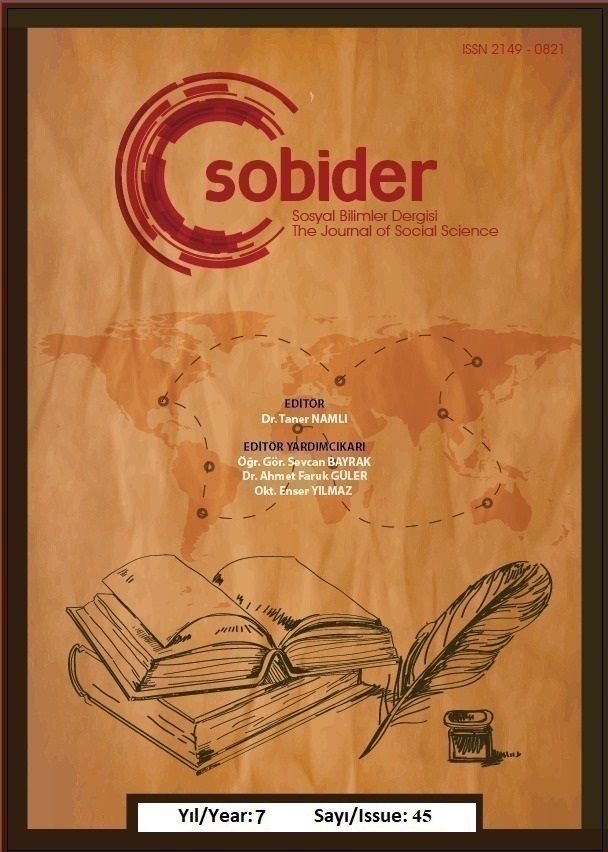Author :
Abstract
Bu çalışma ortalama tüketim eğiliminin durağan olup olmadığını Türkiye ekonomisi için incelemektedir. Bu amaçla Genişletilmiş Dickey-Fuller (ADF), Phillips ve Perron (PP) birim kök testleri ve Lee-Strazicich yapısal kırılmalı birim kök testi kullanılmış ve Türkiye ekonomisinde genel itibariyle ortalama tüketim eğiliminin durağan olmadığı sonucuna ulaşılmıştır. Bu durumda genel itibariyle APC’nin uzun dönemde ortalamaya geri dönmediği ve herhangi bir şokun APC üzerinde kalıcı bir etki yaratacağı söylenebilir. Dolayısıyla çalışmada APC’nin uzun dönemde bir sabite yakınsamayacağı bulunmuştur. Bu sonuç Türkiye ekonomisinde Keynes (1936)’in Mutlak Gelir Hipotezi, Marksist Yetersiz Tüketim Teorisi ve Deaton (1977)’un İhtiyari Olmayan- Zorunlu Tasarruf Teorisi’nin geçerliliğini desteklemektedir.
Keywords
Abstract
This article investigates whether average propensity to consume is stationary for Turkish economy. For this purpose, we used Augmented Dickey-Fuller (ADF), Phillips-Perron (PP) unit root tests and structural break Lee-Strazicich unit root test. Our findings suggest that, APC is not generally stationary. As a result of these findings, we can generally assert that APC is not mean reverting in the long run and any temporary shock will have permanent effects on APC. Thus, APC does not converge towards a constant in the long run. These results supportes Absolute Income Hypothesıs of Keynes (1936), Marxian Undercompensating Theory, The Involuntary Savings Theory of Deaton (1977).
Keywords
- Ando, A. ve Modıglıanı, F., (1963), “The Life-cycle Hypothesis of Saving: Aggregate Implications and Tests”, American Economic Review, 53 (1), 55–84.
- Arı, A. ve Özcan, B., (2015), “Tüketim- Gelir Oranının Durağanlığı: Türkiye Örneği”, Hacettepe Üniversitesi İİBF Dergisi, 33(3), 23-46.
- Baykara, S. ve Telatar, E., (2012), “The Stationarity of Consumption- Income Ratios With Nonlinear and Asymmetric Unit Root Tests: Evidence From Fourteen Transition Economies”, Hacettepe University Department of Economics Working Papers, 20129, 1-41.
- Cerrato, M., Peretti, C. D. ve Stewart, C., (2013), “Is The Consumption- Income Ratio Stationary? Evidence From Linear and Non- Linear Panel Unit Root Tests For OECD And Non-OECD Countries”, The Manchester School, 81(1), 102-120.
- Cook, S., (2005), “The Stationarity Of Consumption- Income Ratios: Evidence From Minimum Lm Unit Root Testing”, Economics Letters, 89(1), 55-60.
- Deaton, A.S., (1977), “Involuntary Saving Through Unanticipated Inflation”, American Economic Review, 67(5), 899-910.
- Dickey, A. D., ve Fuller, A. W., (1979), “Distribution of The Estimators For Autoregressive Time Series With a Unit Root”, Journal Of American Statistical Associatian’’, 74, 22, 427-431.
- Dıckey, A. D., ve Fuller, A. W., (1981), “Likelihood Ratio Statistics For Autoregressive Time Series With A Unit Root”, Econometrica, http://www.u.arizona.edu/~rlo/readings/278800.pdf 49(4),1057-1072.
- Dumrul, C., (2010), “Türk Ekonomisinde Para İkamesinin Belirleyicilerinin Sınır Testi Yaklaşımı İle Eş-Bütünleşme Analizi”, Erciyes Üniversitesi İktisadi ve İdari Bilimler Dergisi, (35), 199-231.
- Duesenberry, J. S., (1952), Income, Saving and the Theory of Consumer Behavior,Cambridge Mass: Harvard University Press, 128s.
- Elmi, Z. ve Ranjbar, O., (2013), “Nonlinear Adjustment To The Mean Reversion Of The Consumption- Income Ratio”, Economic Modelling, 35(C), 477-480.
- Fallahı, F., (2012), “The Stationarity Of Consumption- Income Ratios: Evidence From Bootstrapping Confidence Intervals”, Economics Letters, 1115(1), 137-140.
- Frıedman, M., (1957), A Theory of the Consumption Function, Princeton University Press, Princeton, 296s.
- Gomes, F. A. R. ve FRANCHINI, D. D. S., (2009), “The Stationarity Of Consumption- Iıncome Ratios: Evidence From South American Countries”, Economia Applicada, 13(4), 463479.
- Gozgor, G., (2013), “Stochastic Properties Of The Consumption- Income Ratios In Central and Eastern Euroepan Countries”, Zb. Rad. Ekon. Fak. Rij,, 31(2), 193-207.
- Kargı, B., (2014), “Evidence for Turkey's EconomyPermanent Income Hypothesis: Time Series Analysis (2004-2012)”, Akademik Bakış Dergisi, (42), 1-18.
- Kuznets, S., (1946), National Income: A Summary of Findings, National Bureau of Economic Research, New York, 144s.
- Lee, J. ve Strazicich, M. C., (2003), “Minimum Lagrange Multiplier Unit Root Testwith Two Structural Breaks”, The Review of Economics and Statistics, 85(4), 1082-1089.
- Lumsdaine, R. ve PAPEİL, D., (1997), "Multiple Trend Breaks and the Unit-Root Hypothesis", Review of Economics and Statistics, 79 (2), 212-218.
- Özcan, S. E., (2007), “Kamu Açık ve Borçlarının Sürdürülebilirliği: 1970-2005 Türkiye Örneği”, Doktora Tezi, Kütahya Dumlupınar Üniversitesi Sosyal Bilimler Enstitüsü, Kütahya.
- Paya, M., (2013), Makro İktisat, 4.Baskı, Türkmen Kitabevi, İstanbul,561s.
- Perron, P., (1989), “The Great Crash, the Oil Price Shock, and the Unit Root Hypothesis”, Econometrica, 57(2), 1361-1401.
- Romero- Avıla, D., (2008), “A Cconfirmatory Analysis Of The Unit Root Hypothesis For OECD Consumption- Income Ratios”, Applied Economics, 40(17), 2271-2278.
- Romero- Avıla, D., (2009), “Are OECD Consumption- Income Ratios Stationary After All”, Economic Modelling, 26(1), 107-117.
- Sarantis, N. ve Stewart, C., (1999), “Is The Consumption- İncome Ratio Stationary?, Evidence From Panel Unit Root Tests”, Economics Letters, 64 (3), 309-314.
- Schmıdt, P. ve PHILLIPS, P. C. B., (1992) “LM Tests for a Unit Root in the Presence of Deterministic Trends”, Oxford Bulletin of Economics and Statistics, 54(3), 257–287.
- Sivri, U., ve Seven, B. (2017). Ortalama Tüketim Eğilimi Durağan Mıdır? Türkiye Ekonomisi için Bir Zaman Serisi Analizi. Anadolu İktisat ve İşletme Dergisi, 1(1), 50-65.
- Solarin, S. A. (2017), "The Stationarity of Consumption-Income Ratios: Nonlinear Evidence in Asean Countries", Romanian Journal of Economic Forecasting, 20(2): 109-123.
- Tarı, R. ve Çalışkan, Ş., (2005), “Kocaeli İlinde Tüketimin Gelir Hipotezlerinin Analizi”, Atatürk Üniversitesi İktisadi ve İdari Bilimler Dergisi, 19(2), 1-19.
- Ünsal, E., (2013), Makro İktisat, Ankara, İmaj Yayınevi, Ankara, 759s.
- Yılancı, V., Zeren, F. ve ARI, A., (2013), “Tüketim- Gelir Oranı Güneydoğu Asya Ülkelerinde Durağan Mı?”, Yönetim ve Ekonomi Araştırmaları Dergisi, (21), 130-139.
- Yıldırım, K., Mercan, M. ve Kostakoğlu, S. F., (2013), ”Satın Alma Gücü Paritesinin Geçerliliğinin Test Edilmesi: Zaman Serisi ve Panel Veri Analizi”, Eskişehir Osmangazi İİBF Dergisi, 8(3), 75-95.
- World Bank (Dünya Bankası), “World Development Indicators”, http://databank.worldbank.org/data/reports.aspx?source=world-development-indicators (01.06.2017).
